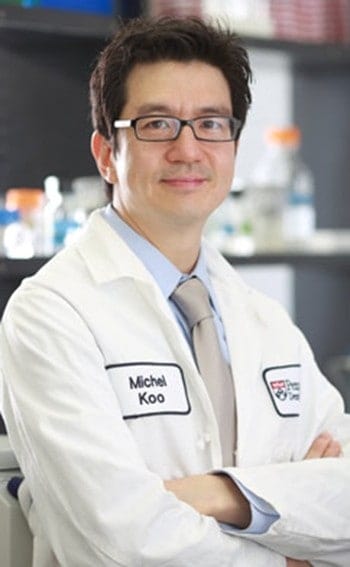Nanotechnology may sound futuristic, but it has already found its way into household products, from cosmetics to cleaning solutions. And with a little help from a School of Dental Medicine professor, consumers may one day even find nanoparticles in a tube of toothpaste.
A recent study co-led by Hyun (Michel) Koo, a professor in Penn Dental Medicine’s Department of Orthodontics, found that a cavity-fighting drug worked better when encapsulated in a nanoparticle carrier, dramatically reducing the severity and number of cavities in an animal model. The work was published last month in the journal ACS Nano.
The scientists’ goal was to kill cavity-causing bacteria by targeting dental plaque, a biofilm made up of bacteria enmeshed in a glue-like structure of extracellular polymers known as a polymeric matrix. When exposed to sugars—like those found in a tooth-decay promoting diet—dental plaque becomes acidic and wears away tooth enamel, causing cavities.
Though plenty of compounds can kill cavity-causing bacteria, it can be hard to keep them in the mouth long enough to have the desired effect.
“Usually orally delivered therapeutics are only transiently exposed to the mouth—think of a mouthwash or toothpaste in the mouth for only a couple of minutes at the most,” Koo says. “The problem was how to retain bioactive molecules on site to prevent or control oral biofilm formation.”
Koo’s colleagues from the University of Rochester, including engineer Danielle Benoit, were already at work on a drug-delivery mechanism Koo thought could be used against cavities.
“Danielle was using nanoparticles to deliver therapeutic agents to cancer cells and I knew that cancer cells have an acidic microenvironment, like plaque biofilms in the mouth do,” Koo says. “That triggered the idea: We could use nanoparticles to develop a treatment for dental plaque.”
The research team designed a nanoparticle with a positively charged outer layer that would be attracted to tooth enamel and the biofilm matrix, and an inner layer to hold the drug—a compound called farnesol that is known to have antibacterial properties. The inner layer contained pH-responsive molecules that destabilize in acidic conditions, acting like a homing device to release the farnesol precisely when and where it is most needed.
The researchers applied the nanoparticle solution to the mouths of rats that had been infected with a microbe that causes tooth decay and were fed a cavity-promoting diet, rinsing their teeth twice daily for 30 seconds, just as a person might use a mouthwash morning and night.
Koo says the farnesol alone had no effect on the number of caries and only a tiny effect on their severity.
“But with the nanoparticle, both the number and severity of caries was reduced,” he says.
Working with the Penn Center for Innovation, Koo has filed a patent on related technology. Earlier this year, a member of Koo’s lab, postdoctoral researcher Lizeng Gao, won the prestigious 2015 International Association for Dental Research Innovation in Oral Care Award for nanotech strategies to treat cavities. With further research into nanotechnology-based treatments, Koo says, “the ultimate goal is to take this to the clinic.”



Look Honest Abe… Instead of questioning us, go out and discover these answers, and come back and tell us. I don’t know those answers
So your resolve is to boldly go forth and discover what their is to discover, not taking any caution in the consequences of the discovery? Slightly off topic, but still on new endeavors, scientists are trying to incorporate the immune system to attack cancer (Find out more info: https://scienceblog.com/77817/recruiting-the-entire-immune-system-to-attack-cancer/#Pvj8pGAyorLby02O.97) I think this is great news, and also a great step forward in the fight for cancer, but I have a giant concern. Tumors are produced by the body and contain human cells, what happens if the opposite effect takes president and transforms our immune system into a giant battleground for an autoimmune disease? Do you think we can incorporate Nanoparticles to assist in this ?
People will always find a way to kill people… Nothing will change human nature, not even Nanoparticles.
Yes, it is true that some destructive things have come from the best intentions, such as the discovery of ecstasy or Zyklon B , which were discovered by scientists to help solve a need, but which led to greater damage… but their is always the other side to that as well. Botulism was used as a bio-weapon, now it is used in cosmetic treatment… All i’m saying is that if you look for the negative in something you’ll find it.
When new endeavors get discovered to help humanity, their is always the subsequent opposite side of the coin, where positive leaps can have deadly and negative consequences. Nano-particles are highly untraceable , that can easily be released into the human body, but with fatal consequences. I just suggest we be cautious of what we discover, never know when we will discover the next nuclear bomb equivalent.
That is true, their are always risks to new discoveries of technology, especially if it comes to medicine, but it’s good to see new studies opening, such as nanoparticles being used as a more effective transport delivery system to tumour cells.
It’s interesting how much collaboration across scientific fields can lead to an increase in understanding for all involved. Nanotechnology is something that, once mastered, could benefit everyday life and further science and technology exponentially. It is impressive that there is already research into using nanotechnology to help cure human ailments, but the possibilities thereafter are infinite. There are ethical concerns to address before nanotechnology becomes an accepted form of medication, but further research into the topic could appease those.
Since the properties of nanoparticles are not well known and they can’t be easily predicted, there are worries that nanoparticles may have
undiscovered harmful side-effects. What research can be conducted that can conclude that they will not be harmful to humans?